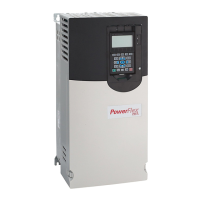5-4 Using the I/O
PowerFlex® 755 Drive Embedded EtherNet/IP Adapter User Manual
Publication 750COM-UM001A-EN-P
Using Logic Command/
Status
The Logic Command is a 32-bit word of control data produced by the
controller and consumed by the adapter. The Logic Status is a 32-bit
word of status data produced by the adapter and consumed by the
controller.
When using a ControlLogix controller, the Logic Command word is
always DINT 0 in the output image and the Logic Status word is always
DINT 0 in the input image when using the Add-On Profile or DINT 1
when using the Generic Profile. For a PLC-5, SLC 500 or MicroLogix
1100 controller, the Logic Command word is always words 0 (least
significant word) and 1 (most significant word) in the output image and
the Logic Status word is always words 0 (least significant word) and 1
(most significant word) in the input image.
This manual contains the bit definitions for compatible products
available at the time of publication in Appendix
D, Logic Command/
Status Words for PowerFlex 750-Series Drives.
Using Reference/Feedback
The Reference is a 32-bit REAL (floating point) piece of control data
produced by the controller and consumed by the adapter. The Feedback
is a 32-bit REAL (floating point) piece of status data produced by the
adapter and consumed by the controller.
The Reference and Feedback 32-bit values represent engineering units.
For example, a 32-bit REAL Reference value of “30.0” equals a
Reference of 30.0 Hz. Note that the commanded maximum speed can
never exceed the value of drive Parameter 510 - [Max Fwd Speed].
Table 5.C
shows example References and their results for a PowerFlex
755 drive that has its Parameter 37 - [Maximum Freq] set to 130 Hz and
Parameter 520 - [Max Fwd Speed] set to 60 Hz.
When using a ControlLogix controller, the 32-bit REAL Reference is
always DINT 1 in the output image and the 32-bit REAL Feedback is
always DINT 1 in the input image when using the Add-On Profile or
DINT 2 when using the Generic Profile. For a PLC-5, SLC 500 or
MicroLogix 1100 controller, the 32-bit REAL Reference word is always
words 2 (least significant word) and 3 (most significant word) in the
output image and the 32-bit REAL Feedback is always words 2 (least
significant word) and 3 (most significant word) in the input image.
Because the I/O image is integer-based and the Reference and Feedback
are floating point, a COP (Copy) instruction or UDDT is required to
correctly write values to the Reference and read values from the
Feedback. See the ladder logic program examples in Figure 5.8
and
Figure 5.9
.
TIP: When using the drive-specific add-on profile, the controller tags
for Reference and Feedback are automatically and properly formatted.
This eliminates the need for data conversion using COP (copy)
instructions or a UDDT.

